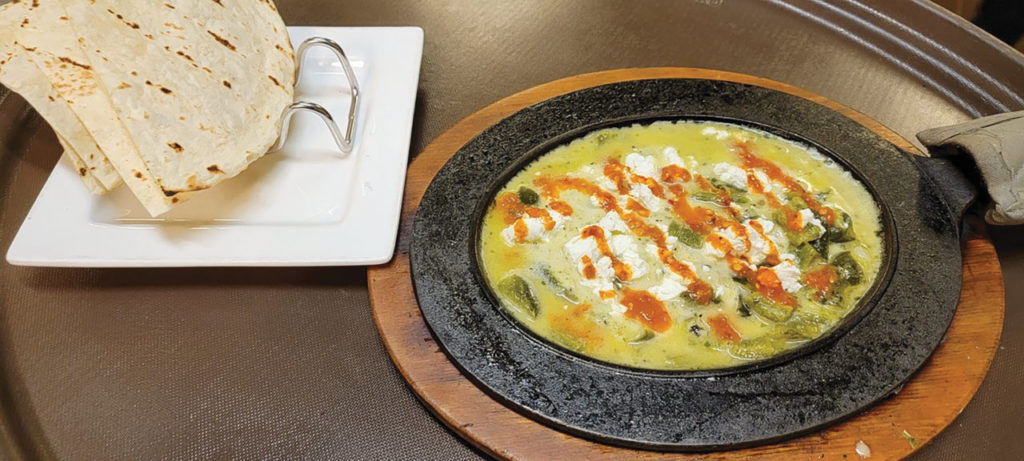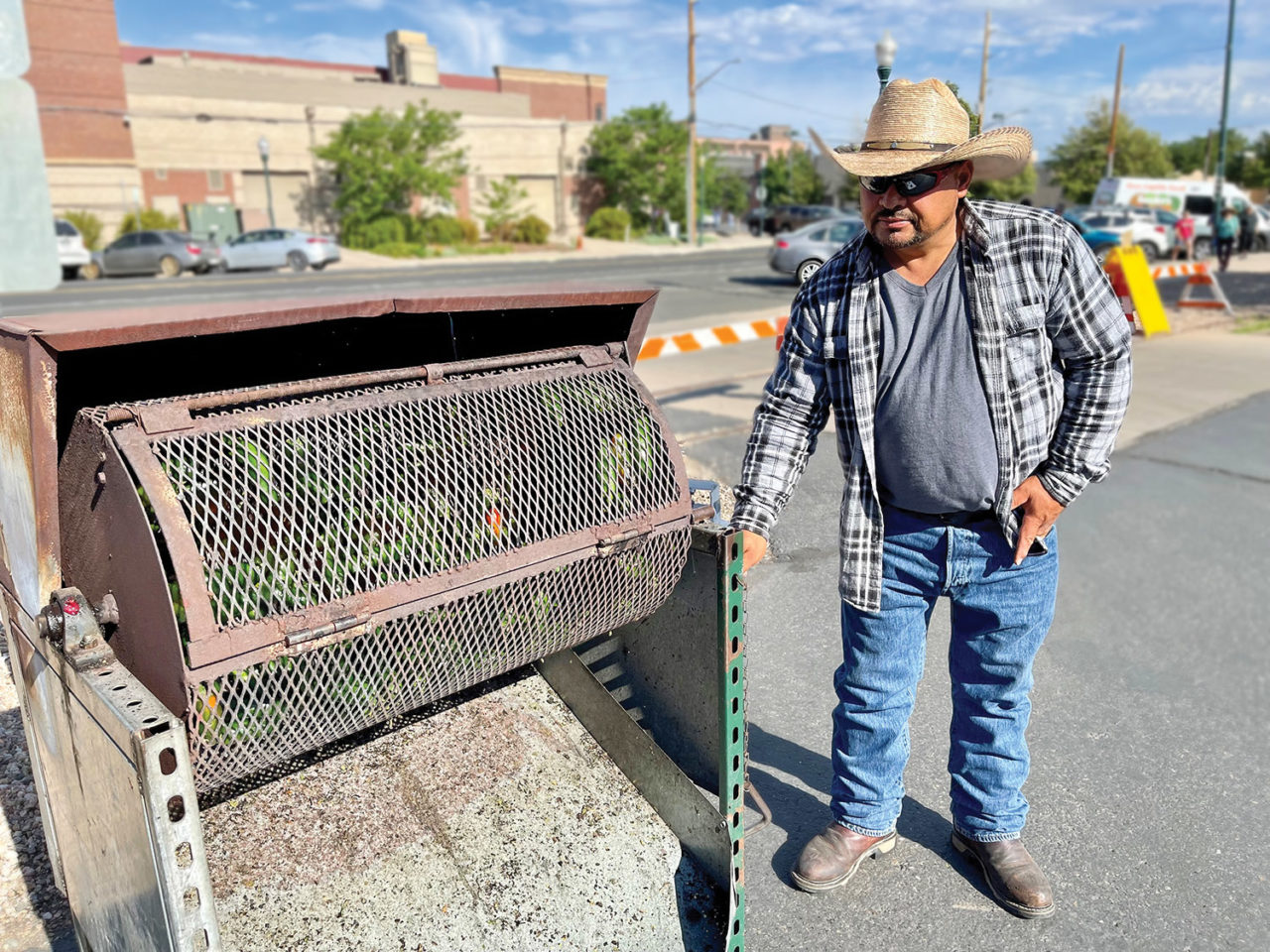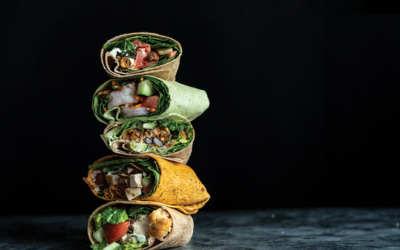José Dominguez grasps the handle of the tumbler and gives it a few cranks to make its cylindrical basket twirl. The motion sends sparks flying as the green chiles inside jump and bounce.
Even standing 20 feet away from the chile roaster at the Greeley Farmers Market, you can smell the aroma of roasting chiles and hear them crackle and pop as they blister and char.
In Colorado, chile peppers are culinary mainstays. From salsa and green chile stew to margaritas and cocktails, the state’s culture has long honored this diverse group of fruits from the genus Capsicum. And, as many farmers market shoppers will attest, when the green chiles are in season and roasting at market, we can’t seem to get enough of them.
Dominguez and his family work at Gonzales Farms and grow five acres of chiles, including Anaheim, jalapeño, serrano, dynamite and poblano. On market Saturdays, Dominguez roasts about 10 bushels; a bushel ranges between 35-50 pounds, depending on the chiles’ size. Those who roast them cool and peel them by hand, leaving bits of blackened skin clinging to the flesh. Then they’re bagged and sold to customers for immediate use, or they can be frozen.
Chiles can be eaten raw, roasted and peeled, incorporated into a sauce or stew or served whole, where they’re often stuffed and baked or draped across omelets or layered in casseroles.
Their taste profile includes texture: larger peppers like the Anaheim, poblano or jalapeño have meatier flesh; others, like serrano and Thai chiles, have thinner walls.
Their heat level depends on the variety and the amount of the chemical capsaicin a chile has. Growing conditions and time of harvest are factors; less water can make for a hotter bite.
The heat is concentrated in the white pith attached to the seeds. If you’re concerned about too much heat, reduce it by removing both.
The standard reference is the Scoville Heat Unit scale, which ranks pungency in multiples of 100. This subjective test was developed by chemist Wilbur Scoville in 1912, when a panel sipped increasingly diluted concentrations of ground chiles blended with sugar water until their mouths stopped burning. At zero, sweet bell peppers rank lowest on the scale; the highest is the Carolina Reaper, which can reach a mouth-scorching 2,100,000 units.
Hatch green chiles—prized for their meaty texture and considered the bellwether of green chiles—are grown in the Hatch Valley of New Mexico and range between 5,000 to 6,000 units. Poblanos—large, shiny and dark green—measure about 1,000 to 2,000 units. Jalapeños can reach 8,000 units and serranos have medium heat, ranging between 8,000 and 22,000 units. Contrary to popular lore, India’s Bhut Jolokia “ghost pepper” is hot, but not the hottest in the world. Its pungency range—between 1,020,000 to 1,578,000—pales in comparison to the Carolina Reaper, but the juice can still blister your skin.
Colorado’s dry climate is ideal for growing most peppers, including the scorchers, which surprisingly have a sweet, fruity flavor. The burn starts about 30 seconds after eating them. Remember to wash your hands well after handling them and don’t touch your eyes: they’ve been known to drive an eater to the local emergency room in search of medical attention.
Green chiles start out green but once the seed pods have matured and the nutrient source is gone (including water), they can turn red; that’s when they’re dried and ground into chile powder. Red chiles have a more intense flavor but are no hotter than when the chile was green.
Cooking with chiles at Blue Agave Grill
Trevor Schultze, corporate chef for the Lucio Restaurant Group, integrates roasted chiles into Blue Agave’s house guacamole and green chile. Roasted poblanos are used for an open-faced relleño stuffed with shrimp and bacon or chorizo; tequila lime chicken is garnished with a roasted poblano strip; and jalapeños perk up the pico de gallo, pineapple salsa and a fire-roasted salsa with a slow, smoky heat.
“We go through 30-40 pounds of jalapeños weekly and source New Mexico green chile from a Colorado company, Bueno Foods, that roasts, peels, seeds and dices them. They’re frozen and packaged into five pound bags, both hot and mild,” Schultze says.
Blue Agave Grill in Fort Collins slow-cooks chiles with water for 3-4 hours to break them down for that ideal saucy consistency; the restaurant’s version of green chile is gluten free. Blue Agave also has a vegan green chile prepared with vegan stock served smothered over a plant-based burrito. Other restaurant concepts in the group, Coyote’s Southwestern Grill (Greeley) and Palomino Mexican Restaurant (Loveland), use flour to thicken their green chile.
The bar program incorporates chiles, too, says regional manager Rob Duran, including Monte Alban 100% Blue Agave tequila that’s house-infused with jalapeños and served by the shot or in their Muy Macho Jalapeño Margarita.
For a unique chile sip, try the Piña en Fuego, a spicy, smoked pineapple cocktail with a kick made with damiana-infused mezcal, fresh lime, pineapple juice and Ancho Reyes Verde Chile liqueur made from poblanos. Added bite comes from Bitterman’s Hellfire Shrub made with habañeros.
Restaurants use chiles year-round. But you can get them fresh in late summer and early fall. Look for them at area farmers markets and from mid-August through mid-October at Tigges Farm, 12404 County Road 64 1/2 in Greeley.

Panroasted chicken in poblano cream sauce is as close to chile comfort food as you can get in one bowl. Serve with mashed potatoes and sautéed zucchini and yellow squash
Pan-Roasted Chicken in Poblano Cream Sauce
Recipe courtesy of Feeding the Famished
INGREDIENTS
3 pounds bone-in chicken, mixture of breasts and thighs
6 Tbs. extra virgin olive oil
2 medium poblano chiles
1 cup diced Hatch green chiles (canned or frozen)
2 cups low-salt chicken broth
1 cup half-and-half
1/3 cup diced yellow onion
1 garlic clove, minced
1/3 cup dry white wine
butter and olive oil
PREPARATION
To prepare poblano chiles:
Place poblano chiles on a gas burner (or alternatively, broil until charred). Turn occasionally to char evenly. Put peppers in glass bowl, cover with a plate, and let them sweat for 15 minutes. Peel and remove seeds and ribs. Chop two peppers coarsely and set aside.
Directions:
Brown chicken pieces in batches in 3 to 4 tablespoons olive oil. Remove chicken from skillet and place in clean bowl. In the same skillet, add 2 tablespoons unsalted butter, 2 tablespoons olive oil, onions and garlic and sauté until tender, about 2 minutes. Pour wine into skillet and bring to boil, scraping browned particles loose, until liquid is almost evaporated. Add chicken broth and chiles to skillet and bring to low boil. Nestle browned chicken pieces in broth skin side up. Add any drippings from bowl to skillet. Simmer chicken covered on low for an hour, or until tender.
Remove cooked chicken to clean bowl. Add diced poblano to skillet and warm for several minutes. Add half-and-half to skillet. Stir and adjust salt and pepper. Bring liquid to simmer, making sure to not boil. Carefully pour hot mixture into blender and purée. Return poblano cream sauce to skillet along with chicken. Heat two minutes to warm.
Serve chicken on top of mashed potatoes with cream sauce. Serves 6.

Goat Cheese Queso Fundido. Photo courtesy of Blue Agave Grill.
Goat Cheese Queso Fundido
Recipe courtesy of Blue Agave Grill
INGREDIENTS
2 oz. green chiles, roasted, peeled and diced
2 oz. salsa verde
2 oz. Monterey Jack cheese
2 oz. Asadero cheese
1 oz. goat cheese, crumbled
hot sauce of your choice
PREPARATION
In a small sauté pan, heat two ounces roasted, peeled and diced green chiles and two ounces of salsa verde. Continue cooking over medium heat until slightly thick. Add two ounces Monterey Jack cheese and two ounces Asadero cheese. Stirring constantly, cook on low heat until cheese is fully melted.
Pour mixture onto a hot cast iron skillet or shallow baking dish. Garnish with one ounce of goat cheese crumbled over the top and drizzle with your favorite hot sauce. Serve immediately with flour tortillas that have been grilled until crispy.







